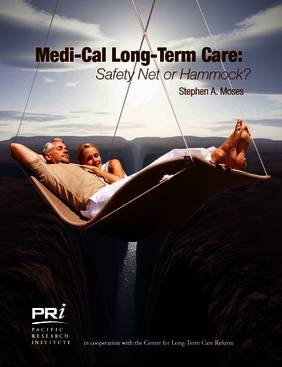Executive Summary
Download Full Study Here.
Watch the Video Here.*
Long-term care is very expensive, whether provided in a nursing home, an assisted living facility, or in someone’s home.
Medi-Cal pays for most professional long-term care in California. It covers 65 percent of nursing home residents and ranks third in the United States for coverage of home and community-based services.
The cost is already huge–$3.8 billion for nursing homes and $6.5 billion for home health and personal care in 2008–and is likely to increase rapidly because of the state’s aging population.
The ability of California’s economy to support a large and growing publicly financed LTC system is doubtful, yet advocates and courts consistently stymie program cutbacks.
Efforts to save money by “rebalancing” from institutional to home care have made Medi-Cal services more attractive and increased caseloads without controlling costs.
Constantly expanding Medi-Cal LTC benefits could cause a financial catastrophe. The path to a better approach lies through understanding why most Californians end up on Medi-Cal when they need LTC.
Conventional wisdom says that Medi-Cal LTC eligibility requires poverty-level income and very low assets. But the truth is that most middle-class people qualify easily for the program. So can the affluent with help from “Medi-Cal planners.”
This report explains how easy and elastic Medi-Cal eligibility rules desensitize the public to LTC risk and cost, resulting in a false sense of security and entitlement.
Medi-Cal not only guarantees generous LTC eligibility, it has failed to implement important restrictions on financial eligibility mandated by federal laws in 1993 and 2005.
Californians’ excessive dependency on Medi-Cal, with its inadequate and uncertain reimbursements, has devastated LTC providers at all levels.
Nursing homes struggle to serve higher acuity (sicker), less profitable residents; assisted living facilities have too few private payers but cannot afford to accept meager Medi-Cal reimbursements. Low-cost home care and adult day health care providers were the first and most severely cut by Medi-Cal.
Easy access for most Californians to Medi-Cal-financed LTC has distorted the service delivery system, causing an institutional bias historically and crowding out a privately financed market for home and community-based services today.
Medi-Cal’s near monopsony (single-buyer market) in LTC financing has desensitized the public to LTC risk and cost, causing most Californians to ignore LTC planning until paying privately for care is prohibitively expensive or less desirable than relying on public assistance.
Consequently, the four primary alternative private LTC financing sources that could relieve financial pressure on Medi-Cal–personal asset spend-down, estate recovery, home equity conversion, and LTC insurance–remain largely untapped.
The CLASS Act, a new voluntary LTC financing program created by “health reform,” aka Obamacare, gives some of our interviewees hope but leaves most experts convinced it will quickly become insolvent due to low participation, adverse selection, moral hazard, and unlimited lifetime benefits.
California’s Medi-Cal LTC safety net provides quality care for too few and a publicly funded long-term care “hammock” for too many. The system is financially unsustainable and ethically questionable.
A better approach is to remove the counterproductive incentives in Medi-Cal that have trapped generations on taxpayer-financed LTC.
The solution is to target Medi-Cal to the needy and privately uninsurable. Medi-Cal should not remain free “inheritance insurance” for the baby-boom generation at the expense of taxpayers, the poor, and the disabled. Fewer Medi-Cal dependents and more private payers would encourage a vibrant private-pay home- and community-based services infrastructure with a strong reverse mortgage and private LTC insurance market to help pay for it.
Unfortunately, federally mandated easy eligibility, extravagant supplemental federal matching funds, and “maintenance of effort” rules have made fixing Medi-Cal in this way difficult, if not impossible.
Dropping out of the federal program may be an option. Dennis Smith, the official who ran Medicaid during the Bush administration believes California could actually save $133 billion by dropping out of Medi-Cal, of which $7 billion would come from reducing LTC spending 10 percent over the next seven years.
With or without participating in Medicaid, California should:
Clearly establish the principle that long-term care is a personal responsibility, not a social “right.”
Conduct a comprehensive review of the current LTC service delivery and financing system to identify and eliminate policies that encourage public dependency.
Incentivize the middle class and affluent to plan early and save, invest, or insure for LTC.
Reduce the number of expensive Medi-Cal/Medicare “dual eligibles” in the future by diverting more Californians to private
LTC financing alternatives while they are still young enough, healthy enough, and affluent enough to save, invest, or insure for LTC.
By applying these principles, long-term care service delivery and financing in California can grow private markets, create jobs, and generate tax revenues in home care, assisted living, adult day health, home equity conversion and long-term care insurance. Long-term care services can also do a better job for genuinely needy people who depend legitimately on a radically smaller social LTC safety net.
Such an approach can save taxpayers $375 million per year by more aggressively enforcing stricter LTC eligibility rules allowed by current federal law; $131 million per year by maximizing Medi-Cal estate recoveries; and $1.25 billion per year by going beyond current federal statutory authorities either with a waiver or by dropping Medicaid altogether.
*You can watch a short video explaining the eligibility loopholes in the Medi-Cal LTC program on PRI’s Youtube Channel.

